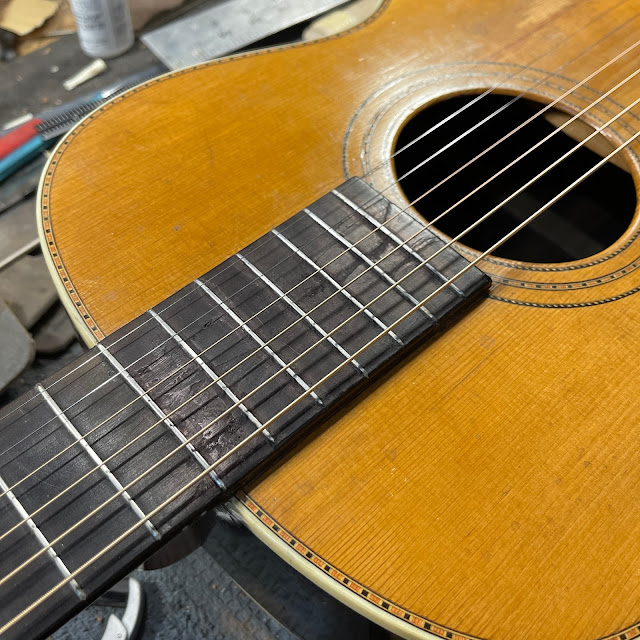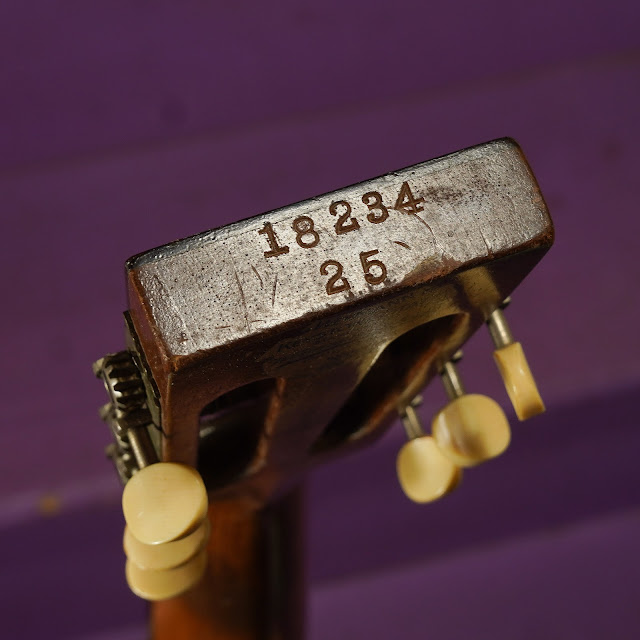1915 Weymann Style 25 00-Size Flattop Guitar
Update 2023: I finally got back to this guitar and "re-reset" the neck angle to a shallower one. That was hairy! Here are the results -- much better:
Now back to the original post...
Weymanns come now and then through the shop but they sure are hard to find out in the world as guitars, aren't they? They're high-quality instruments and were made in Philadelphia. One can find their banjos all over the net and their Mandolute mandolins as well, but their guitars are much rarer birds.
In the last 5 or so years I've worked on more Weymann guitars than I could ever imagine running-across on my own thanks to some great consignors and repair customers. Back in 2015 I worked on one of this same model and that one was built just a few years previous to this and they're the two fanciest Weymanns I've had my hands on (guitar-wise). Like the other, this is a 12-fret, 00-size instrument and features a ladder-braced spruce top, Brazilian rosewood for the back and sides, and restrained but pretty trim throughout.
Unlike a ladder-braced Larson-style instrument of the time (which is the closest similar build profile, I think), these Weymanns have a bit more of a warm, robust, punchy sound. Similar quality instruments would have been built by Vega or Bauer, too, but those are more on the "sparkle and chime" end of the spectrum like the ladder-braced Larsons.
They absolutely love being tuned down because of their long scale (25 3/4" on this one), though because the build is lighter I don't suggest anything heavier than 50w-11 for tuning up to E-to-E standard. I like 12s for a step down to D or 13s for a couple steps down to C or C#. They sound best as fingerpickers, I think, but make good-sounding flatpickers as well. You can lean into them a little more than your average guitar from the time.
There were some old repairs to the guitar which I shored-up and got a little frustrated over and then I had to do a whole bunch myself as well, but post-repairs it's playing spot-on and is ready to go.
Repairs included: a neck reset, heel repair, fretboard extension repair, fret level/dress, side dots install, new ebony bridge, new bone saddle(s), hairline crack repairs/cleats, new bone nut, setup, etc...
Top wood: solid spruce
Back & sides wood: solid Brazilian rosewood
Bracing type: ladder
Bridge: ebony
Fretboard: ebonized maple
Neck wood: mahogany
Action height at 12th fret: 3/32” bass 1/16” treble (fast, spot-on)
String gauges: 50w-11
Neck shape: medium-bigger V
Board radius: 20"
Neck relief: straight
Fret style: smaller/lower
Scale length: 25 3/4"
Nut width: 1 13/16"
Body width: 14 1/2"
Body depth: 4 3/8"
Weight: 3 lbs 9 0z
Condition notes: the finish is original throughout and looks good, though it has pickwear on the top and various small scratches, nicks, and dings here and there. The top has 6 repaired (cleated, filled) hairline cracks and there's a repaired hairline crack on the back as well. The side has a couple of tiny little vertical cracks from dryness that are stable and hard to find. The fretboard extension over the body is a bit of a mess -- someone had reglued it with something other than normal glues and due to the fussy nature of ebonized wood becoming fragile over time, it shattered a bit when I took it up to do the neck reset. It fit it all back together as well as I could and it's not obvious until you get a look at it in glare. The neck and extension had been previously reset at a too-low angle.
Also: the heel has a tight hairline crack in its lower 1/3 which I've both reglued and also reinforced with a vertical hidden screw/bolt. There's a photo or two of this but it's hard to see as it went back together nicely. A lot of Weymanns have this because the heel is not dovetailed -- it sits in a very shallow tenon joint and so the lower portion of the heel is fragile as it's only about 3/4" or so wide beyond the midpoint.
Also: I reset the neck angle a little too steep so it needs a taller saddle. I have a second (lower) saddle stowed in the case for "summer" weather or for when this guitar settles-in. I expected the top to deflect just a little more after stringing (and it may), but for now it has a saddle that's a hair too tall. Structurally, it's happy, though -- not leaning, no weird deflection in the top from too much torque, and a little over 45-degree back-angle on the saddle from the pins.
Also: there's a name (Browne) on the back of the headstock.
It comes with: a '60s-era, Lifton-branded, hard case -- plus extra ebony bridge pins and a slightly-lower additional bone saddle.


































Comments